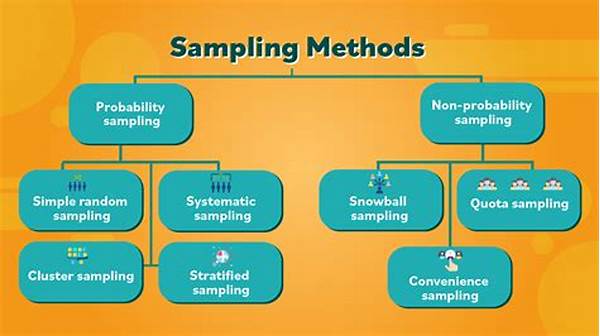In the field of statistics, sampling methods play a pivotal role in ensuring that the data collected is representative and reliable. The process of selecting a sample from a larger population determines the quality and validity of the inferences drawn from the data analysis. Sampling methods in statistics are designed to facilitate this process by providing structured approaches to sample selection. Understanding and choosing the correct sampling method is crucial for researchers and professionals who aim to obtain accurate and unbiased results, thereby enhancing the overall credibility of their statistical studies.
Read Now : Reducing Carbon Emissions In Industry
Importance of Sampling Methods
Sampling methods in statistics are essential tools used to gather insights from a population without the impracticality of studying the entire population. These methods offer a pathway to generate conclusions that are generalizable to the entire group. With the diversity and complexity of populations, sampling methods provide a means to capture the essence of the population characteristics efficiently. Moreover, these methods assist in reducing costs and saving time while maintaining a high level of accuracy. The correct sampling technique ensures representativeness, mitigating the risk of sampling bias and enhancing the validity of the statistical analyses conducted. Thus, the application of appropriate sampling methods is paramount to the success of any statistical investigation.
Key Types of Sampling Methods
1. Simple Random Sampling: This method involves selecting a sample purely by chance, providing each member of the population an equal opportunity to be chosen. Simple random sampling is fundamental to minimizing selection bias, thereby ensuring the results are unbiased.
2. Systematic Sampling: This involves selecting samples at regular intervals from an ordered list. Systematic sampling is praised for its simplicity and ease of execution, often being used when a complete list of the population is readily available.
3. Stratified Sampling: In stratified sampling, the population is divided into strata, or subgroups, and samples are taken from each subgroup. This method is beneficial when certain segments of the population need to be represented proportionally.
4. Cluster Sampling: This method involves dividing the population into clusters and then randomly selecting entire clusters. Cluster sampling is effective in reducing costs and is often used in geographically dispersed populations.
5. Convenience Sampling: Often viewed as the least rigorous, this method selects samples based on ease of access. While cost-effective, convenience sampling risks higher levels of bias and lower representativeness.
Challenges in Sampling Methods
Sampling methods in statistics face several challenges that can impact reliability and validity. One prominent challenge is the presence of bias, which can arise from non-random selection procedures. Sampling bias can distort the findings, leading to inaccurate conclusions. Another challenge lies in the potentially high cost and resource demands of certain methods, particularly when attempting to ensure complete randomness and representativeness. Additionally, researchers must consider the size of the sample, as too small a sample may not adequately reflect the population, while too large a sample can strain resources unnecessarily. Addressing these challenges requires meticulous planning and an in-depth understanding of sampling techniques.
Strategies to Optimize Sampling Methods
1. Ensure clarity in the definition of the population to avoid scope inaccuracies.
2. Choose the sampling method that aligns best with the research goals and available resources.
3. Implement pre-testing and piloting phases to identify potential biases early on.
4. Utilize stratification to ensure representation of all key characteristics within the population.
Read Now : Economic Benefits Of Renewable Energy Adoption
5. Employ statistical tools and software to facilitate randomization and reduce manual errors.
6. Evaluate and adjust the sampling method as necessary to maintain flexibility and responsiveness to emerging data issues.
7. Collaborate with statisticians to leverage their expertise in refining sampling strategies.
8. Document and justify the choice of sampling method to enhance transparency and reproducibility.
9. Incorporate a contingency plan to address unforeseen challenges during the sampling process.
10. Regularly review and update sampling methodologies in line with technological advancements and new research findings.
Implications of Sampling Methods
Sampling methods in statistics have profound implications for research outcomes. By choosing an appropriate sampling approach, researchers can ensure that their data is reliable, valid, and applicable to the wider population. Inaccuracies or biases in sampling can lead to flawed interpretations, which may misinform policy decisions or scientific understanding. Additionally, a well-executed sampling method enhances the credibility of the research, fostering trust and acceptance among stakeholders. It is vital for researchers to remain cognizant of the implications that their choice of sampling method can have, thus incentivizing a rigorous evaluation process prior to implementation.
Summary of Sampling Methods in Statistics
The role of sampling methods in statistics cannot be overstated, encompassing a range of techniques aimed at extracting representational samples from populations. These methods are fundamental to the integrity of any statistical analysis, influencing both the efficiency and accuracy of data collection efforts. Each sampling method carries distinct advantages and possible drawbacks, necessitating a careful selection process according to the specific needs of a study. As statistical environments evolve, so too do the practices surrounding sampling, inviting continuous exploration and adaptation to refine the processes involved.
Conclusion and Future Directions
In conclusion, sampling methods in statistics serve as indispensable tools in the arsenal of researchers and statisticians. By facilitating the capture of reliable data from larger populations, these methods underpin the entire statistical analysis process. As technology progresses and new challenges emerge, ongoing advancements in sampling techniques will likely continue. Future directions may include the integration of machine learning and artificial intelligence to optimize sampling strategies further, potentially revolutionizing the way data is gathered and analyzed. As such, the continuous study and improvement of sampling methods remain a cornerstone of statistical research.
